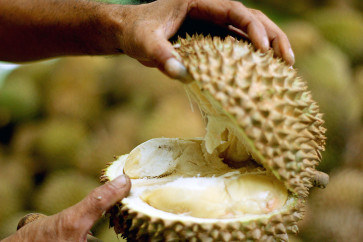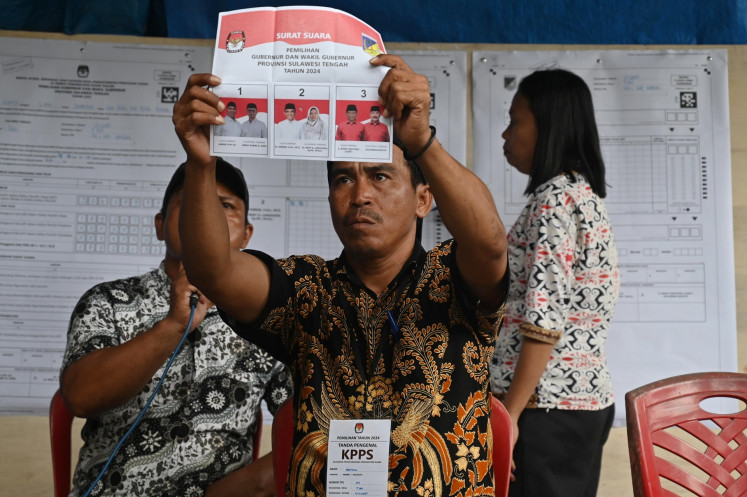Popular Reads
Top Results
Can't find what you're looking for?
View all search resultsPopular Reads
Top Results
Can't find what you're looking for?
View all search resultsWill Indonesia lose the next oil palm?
Deep in the rainforests of Malaysian Borneo in the late 1980s, researchers made an incredible discovery: The bark of a species of peat swamp tree yielded an extract with potent anti-HIV activity
Change text size
Gift Premium Articles
to Anyone
D
eep in the rainforests of Malaysian Borneo in the late 1980s, researchers made an incredible discovery: The bark of a species of peat swamp tree yielded an extract with potent anti-HIV activity. But when the scientists returned to the site to collect more material for analysis, they were shocked to find the tree, and its promise, gone.
Its disappearance triggered a frantic scramble to locate further specimens. Finally, a tree collected 100 years earlier was located in Singapore’s Botanical Garden. Subsequent studies revealed its bioactive compound, canalolide A, to show great potential in treating AIDS. An anti-HIV drug made from the compound is now nearing clinical trials. It could be worth hundreds of millions of dollars a year and help improve the lives of millions of people.
This story is significant for Indonesia because its forests house a similar species. In fact, Indonesia’s forests probably contain many other potentially valuable species, although our understanding of these is poor. Given Indonesia’s biological richness — Indonesia has the highest number of plant and animal species of any country on the planet — shouldn’t policymakers and businesses be giving priority to protecting and understanding rainforests, peatlands, mountains, coral reefs, and mangrove ecosystems, rather than destroying them for commodities? Why can’t it be Indonesian scientists unlocking the value of these natural treasures and Indonesian companies turning them into commercial products?
After all, it is not coal mines, acacia pulp plantations, and oil palm estates that make Indonesia unique — it is biodiversity and cultural heritage, neither of which can be replaced. This is important because both Indonesia’s ecological and cultural richness are fast disappearing, casualties of a Western development model that mostly benefits local elites and outside interests and run roughshod over traditional resource management and the livelihoods they enable.
Sure, converting thousand-year-old rainforest into cash crops yields some short-term profits, but what is the long-term strategy? What happens to palm oil prices if Brazil makes good on its plan to establish more than 5 million hectares of oil palm plantations on non-forest land? Will the most attractive markets discriminate against palm oil that is produced in ways that result in social conflict and environmental degradation?
Markets are already changing. It is increasingly clear that consumer-facing companies, especially in the West but also Brazil, do not want to be associated with social conflict and deforestation. These represent reputational risks to big companies.
For example Indonesia’s largest palm oil producer, PT SMART, lost tens of millions of dollars in business from Unilever, Kraft, and Nestle after being linked to deforestation and conversion of peatlands. The company has since adopted a new forest policy that is among the strongest in Indonesia, prohibiting the conversion of peatlands and rainforests, and requiring free, prior, and informed consent from communities.
These shifts are also happening outside of Indonesia. In Brazil, soy producers and cattle ranchers — who account for the vast majority of deforestation in the Brazilian Amazon — have recently implemented safeguards after protests from some of their largest customers.
“
Nearly 100 million Indonesians are dependent on ecosystem services for things like food, clean air and water, housing and fuel.
”
Brazil’s cattle industry — the largest in the world — was brought to its knees virtually overnight when giant customers said they didn’t want their leather and beef tainted by deforestation and labor abuses.
Furthermore, governments are beginning to enact laws consistent with trends in the private sector. The United States and Europe have recently passed amendments to the Lacey Act and FLEG-T, respectively, to crack down on timber, paper, and wood products that have been sourced illegally.
These regulations do not impose new restrictions on timber harvesting in tropical nations; they merely hold U.S. and European companies responsible for following laws in producer countries. So if timber is illegally logged in Indonesia, it is illegal to sell in the United States.
Despite these trends, Indonesia has been slow to officially define its moratorium on new forest concessions. What’s the hold-up? Put simply, the vested interests that have long taken advantage of a system that enriches them at the expense of most Indonesians are fighting to maintain the status quo.
Some may be paying lip-service to the moratorium, but behind closed doors they continue to push for business as usual. In some cases they have gone as far as to hire foreign consultants like Alan Oxley of World Growth International to concoct dubious reports to defend a Western (non-Indonesian) development model that depends on unsustainable resource extraction and mainly benefits big companies rather than generating government revenues or improving the lives of Indonesian citizens and communities.
We’ve read the claims: implementing the moratorium will cost 3.5 million new jobs a year and throw millions more into poverty. But has anyone actually looked at the data?
Indonesia’s forestry sector does not create anywhere near 3.5 million new jobs per year. The entire Indonesian economy generated 2.5 million new jobs in 2010 and the forest products and plantation industries account for less than 6 percent of the economy, according to government data.
If anything, as Indonesia’s economy matures and modernizes, forestry will continue to decline in significance as a growth engine for the economy — services and knowledge, not bulk commodities, will be drivers of growth. Besides, the moratorium aims to boost productivity on existing lands and restore productivity to degraded lands, not abandon growth.
The Reducing Emissions from Deforestation and Degradation (REDD+) mechanism, which offers to pay Indonesian governments and communities for reducing emissions by preventing further loss of its forests and peatlands, has its flaws but it represents an opportunity to leave the old model, which denigrates Indonesian culture and biodiversity, behind. It offers the chance to embrace the things that make Indonesia unique, while improving the lives of all Indonesians.
Better stewardship of forest resources — through community management and land rehabilitation — will help Indonesia capitalize on new markets for ecosystem services, of which carbon is just the first.
Indonesian business should be leading the transition: Companies that demonstrate environmental stewardship and good community relations — not the lowest cost producers of bulk commodities — are poised to become global leaders.
Finally, let’s not forgot how much Mother Nature offers Indonesia. According to the Economics of Ecosystems and Biodiversity, an E.U.-backed research initiative, nearly 100 million Indonesians are dependent on ecosystem services for things like food, clean air and water, housing and fuel. Ecosystem services account for 2 percent of Indonesia’s GDP — larger than the entire forestry sector — and 75 percent of GDP for Indonesia’s rural poor, a bigger lever for poverty alleviation than plantation agriculture and logging combined.
Biodiversity itself also has value. Remember that the oil palm is a product of rainforest biodiversity — it originated in the forests of West Africa. But will continued deforestation destroy the next potential oil palm or the next anti-HIV drug before it is discovered?
Will Indonesia turn away from what truly makes it unique — its rich cultural heritage and biodiversity — to model the mistakes in the Western developmental model, or will it be a part of developing a new global model for combining prosperity with sustainability?
It’s up to Indonesians to decide.
The writer is a journalist who founded mongabay.com, a forest-focused website. He is based in San Francisco, California, but spends a lot of time in Indonesia










